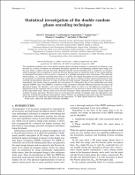Options
Statistical investigation of the double random phase encoding technique
Date Issued
2009-08-24
Date Available
2011-12-08T16:55:25Z
Abstract
The amplitude-encoding case of the double random phase encoding technique is examined by defining a cost function as a metric to compare an attempted decryption against the corresponding original input image. For
the case when a cipher–text pair has been obtained and the correct decryption key is unknown, an iterative attack technique can be employed to ascertain the key. During such an attack the noise in the output field for an attempted decryption can be used as a measure of a possible decryption key’s correctness. For relatively small systems, i.e., systems involving fewer than 5x5 pixels, the output decryption of every possible key can be examined to evaluate the distribution of the keys in key space in relation to their relative performance when carrying out decryption. However, in order to do this for large systems, checking every single key is currently impractical. One metric used to quantify the correctness of a decryption key is the normalized root mean squared (NRMS) error. The NRMS is a measure of the cumulative intensity difference between the input and decrypted images. We identify a core term in the NRMS, which we refer to as the difference parameter, d. Expressions for the expected value (or mean) and variance of d are derived in terms of the mean and variance of the output field noise, which is shown to be circular Gaussian. These expressions assume a large sample set (number of pixels and keys). We show that as we increase the number of samples used, the decryption error obeys the statistically predicted characteristic values. Finally, we corroborate previously reported simulations
in the literature by using the statistically derived expressions.
the case when a cipher–text pair has been obtained and the correct decryption key is unknown, an iterative attack technique can be employed to ascertain the key. During such an attack the noise in the output field for an attempted decryption can be used as a measure of a possible decryption key’s correctness. For relatively small systems, i.e., systems involving fewer than 5x5 pixels, the output decryption of every possible key can be examined to evaluate the distribution of the keys in key space in relation to their relative performance when carrying out decryption. However, in order to do this for large systems, checking every single key is currently impractical. One metric used to quantify the correctness of a decryption key is the normalized root mean squared (NRMS) error. The NRMS is a measure of the cumulative intensity difference between the input and decrypted images. We identify a core term in the NRMS, which we refer to as the difference parameter, d. Expressions for the expected value (or mean) and variance of d are derived in terms of the mean and variance of the output field noise, which is shown to be circular Gaussian. These expressions assume a large sample set (number of pixels and keys). We show that as we increase the number of samples used, the decryption error obeys the statistically predicted characteristic values. Finally, we corroborate previously reported simulations
in the literature by using the statistically derived expressions.
Sponsorship
Science Foundation Ireland
Irish Research Council for Science, Engineering and Technology
Other Sponsorship
Enterprise Ireland
International Society for Optical Engineering (SPIE)
Type of Material
Journal Article
Publisher
Optical Society of America
Journal
Journal of the Optical Society of America A
Volume
26
Issue
9
Start Page
2033
End Page
2042
Copyright (Published Version)
2009 Optical Society of America
Subject – LCSH
Data encryption (Computer science)
Optics--Statistical methods
Optical data processing
Web versions
Language
English
Status of Item
Not peer reviewed
ISSN
1084-7529
1520-8532
This item is made available under a Creative Commons License
File(s)
Loading...
Name
Statistical investigation of the amplitude encoding case of the Double Random Phase Encoding technique.pdf
Size
623.74 KB
Format
Adobe PDF
Checksum (MD5)
46e5633e84ee7936e536c4436d5b5da2
Owning collection